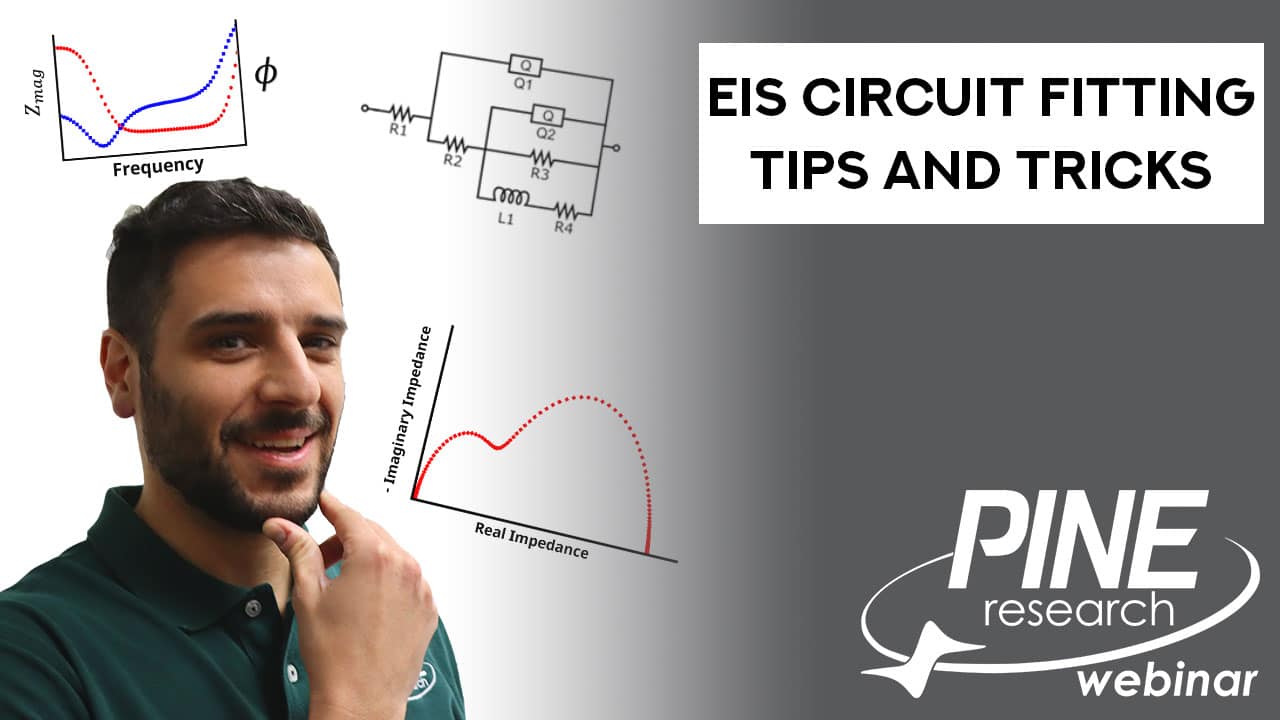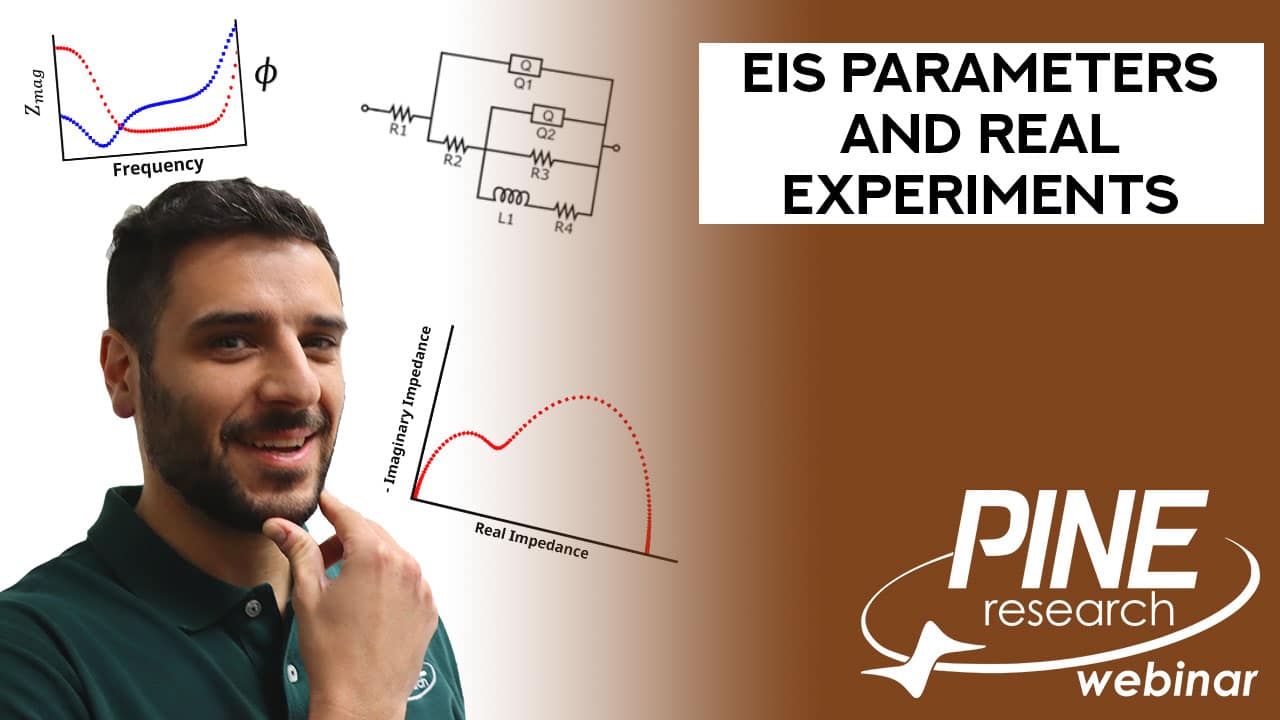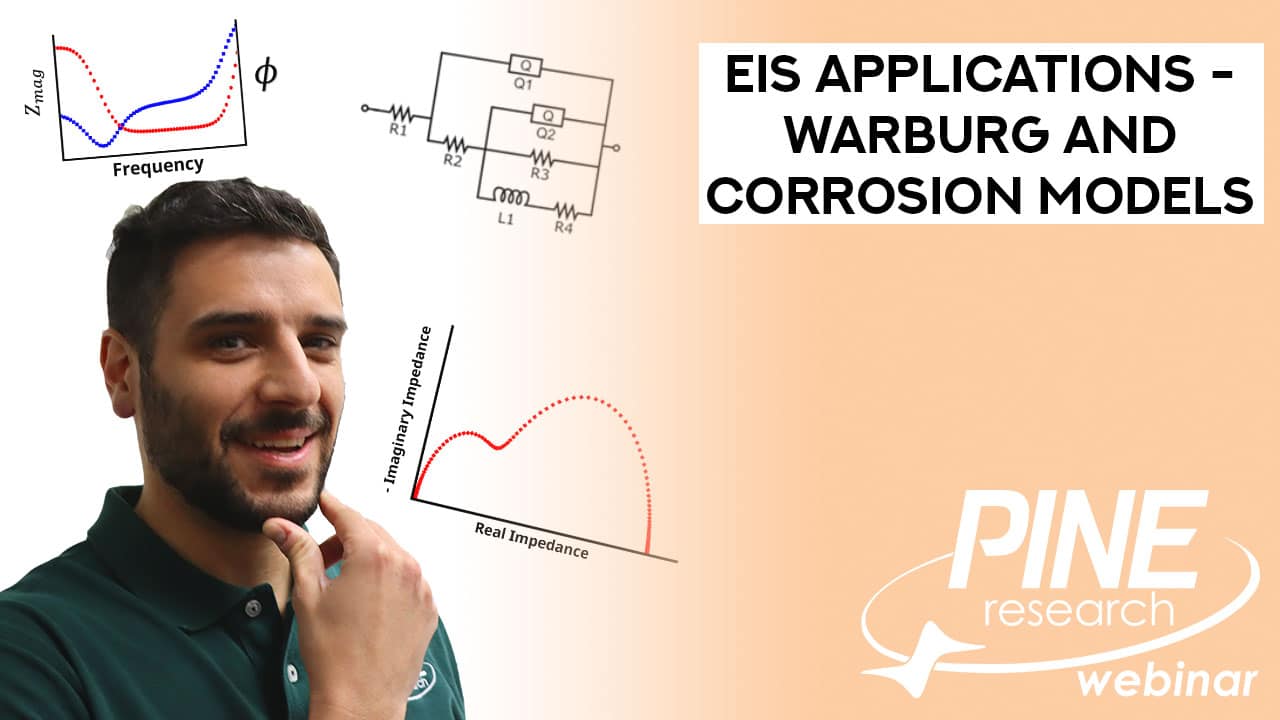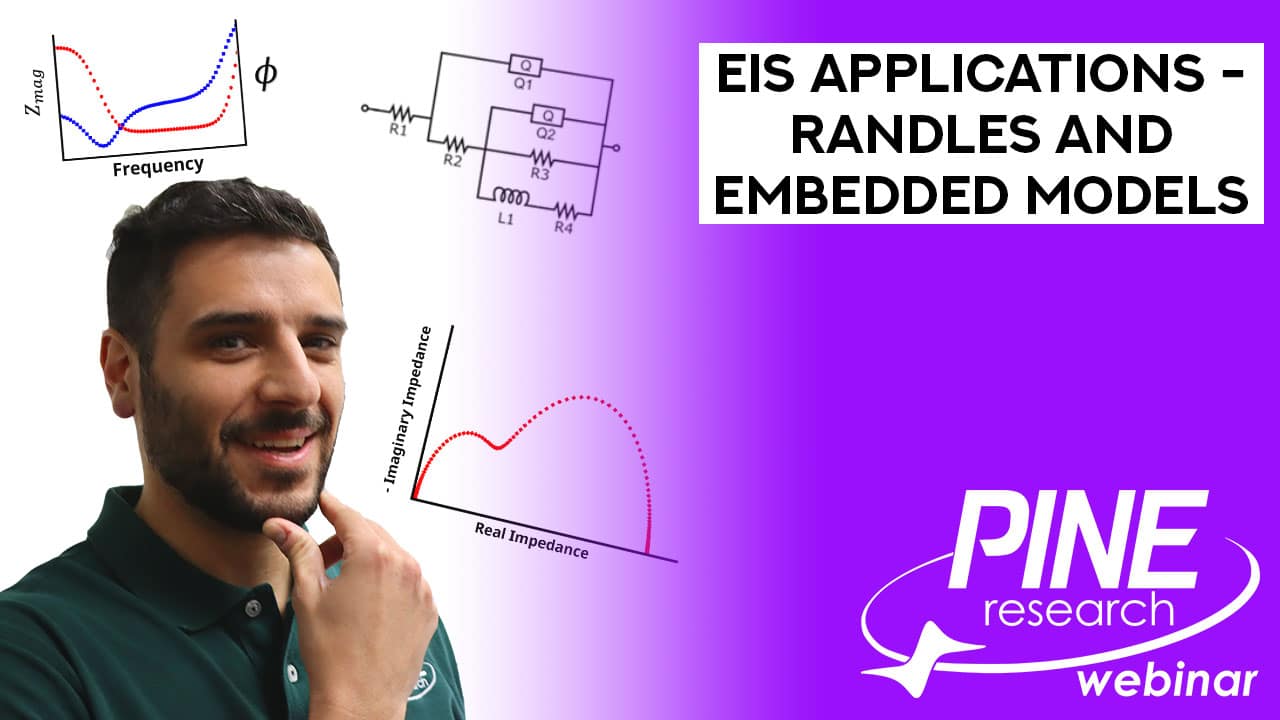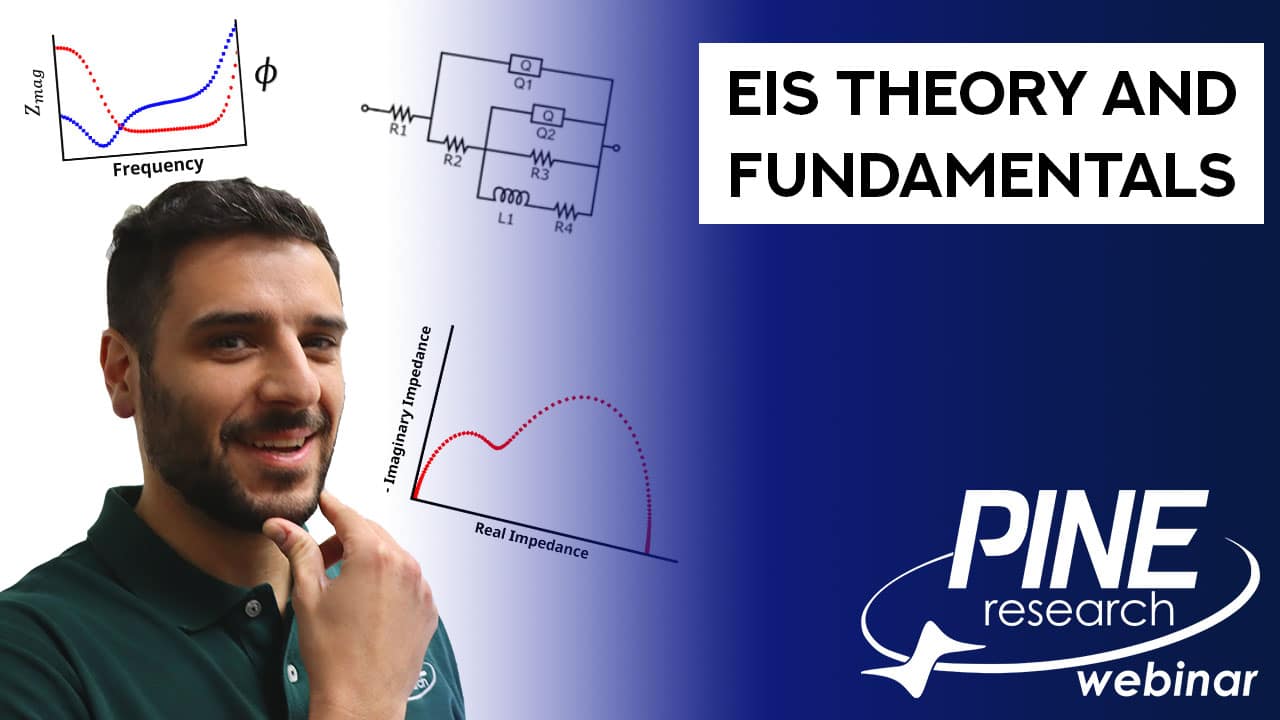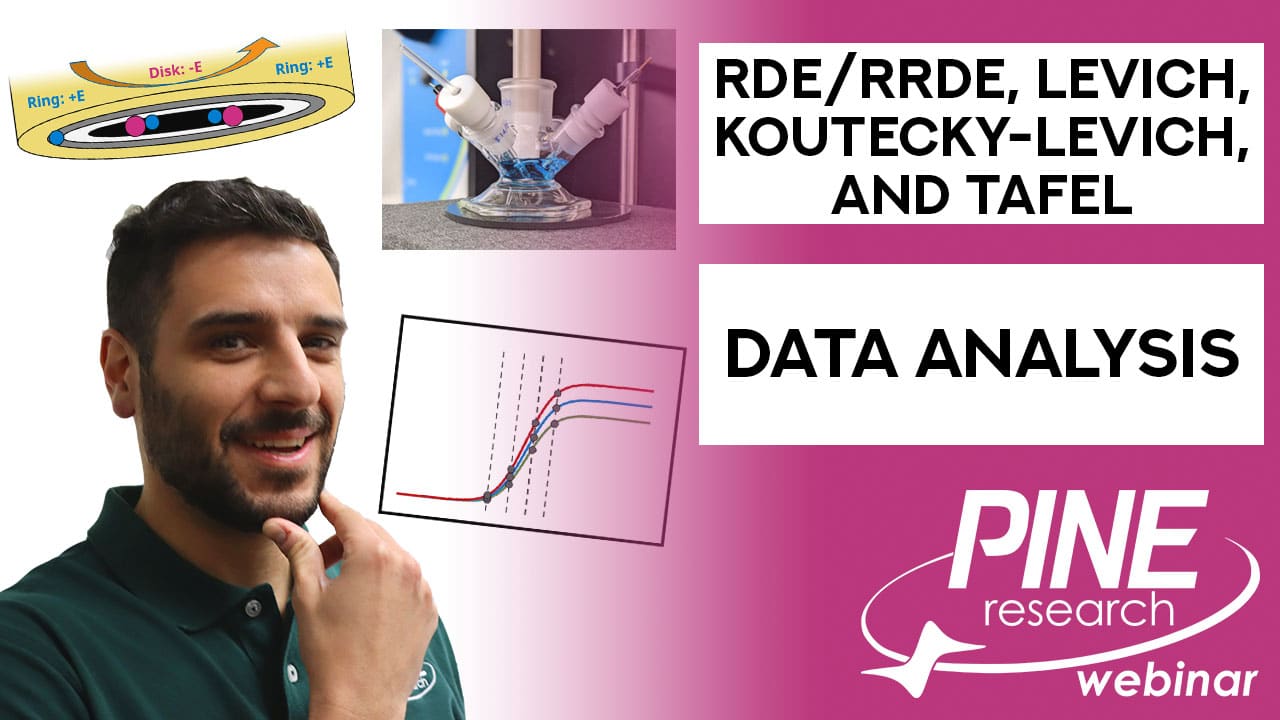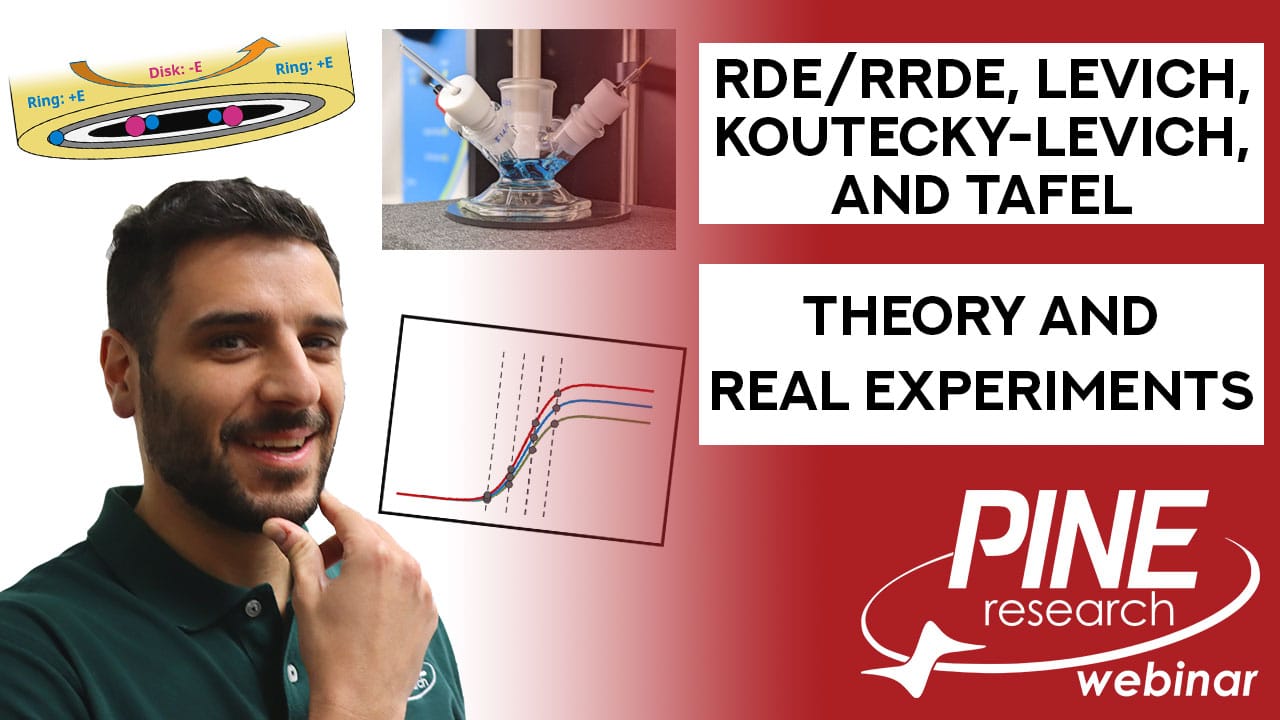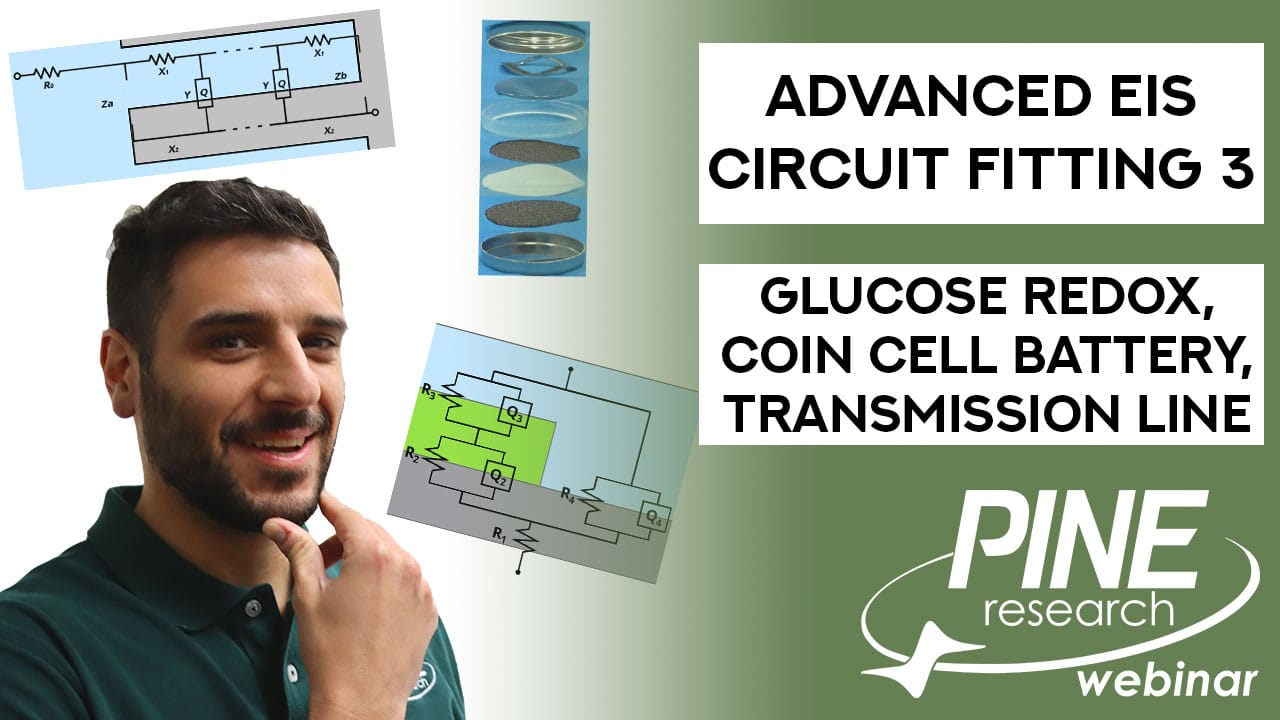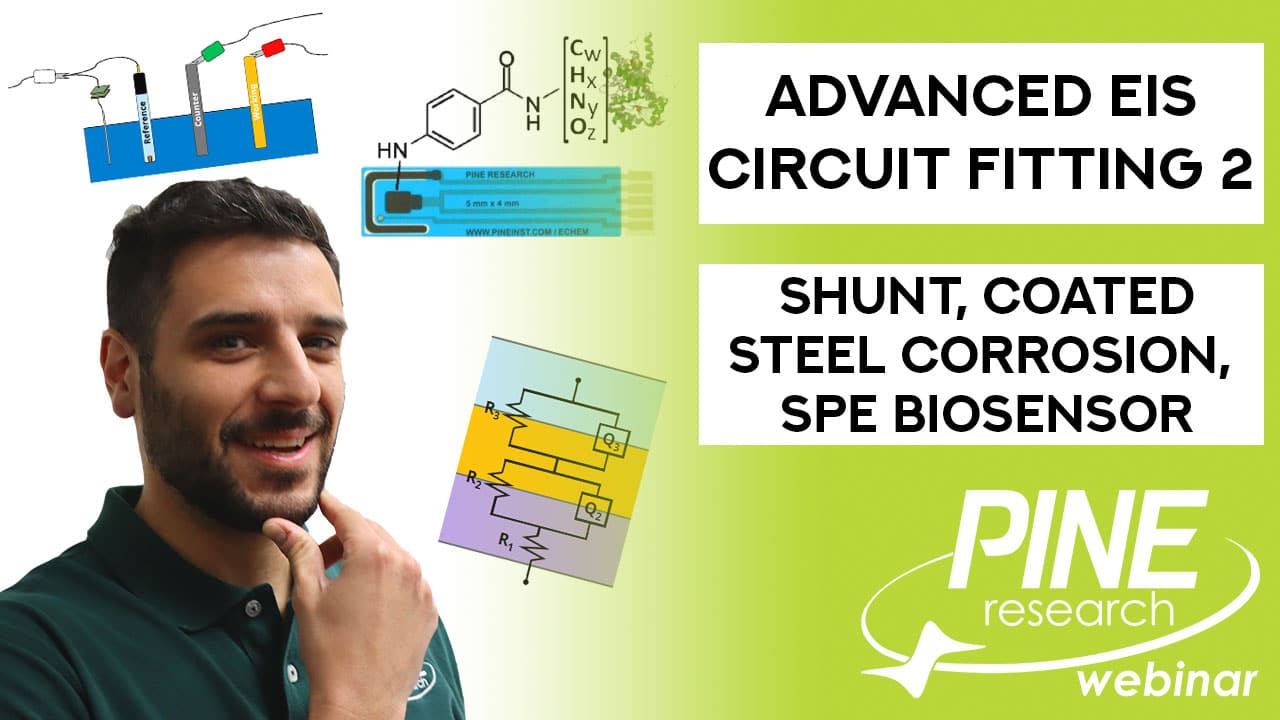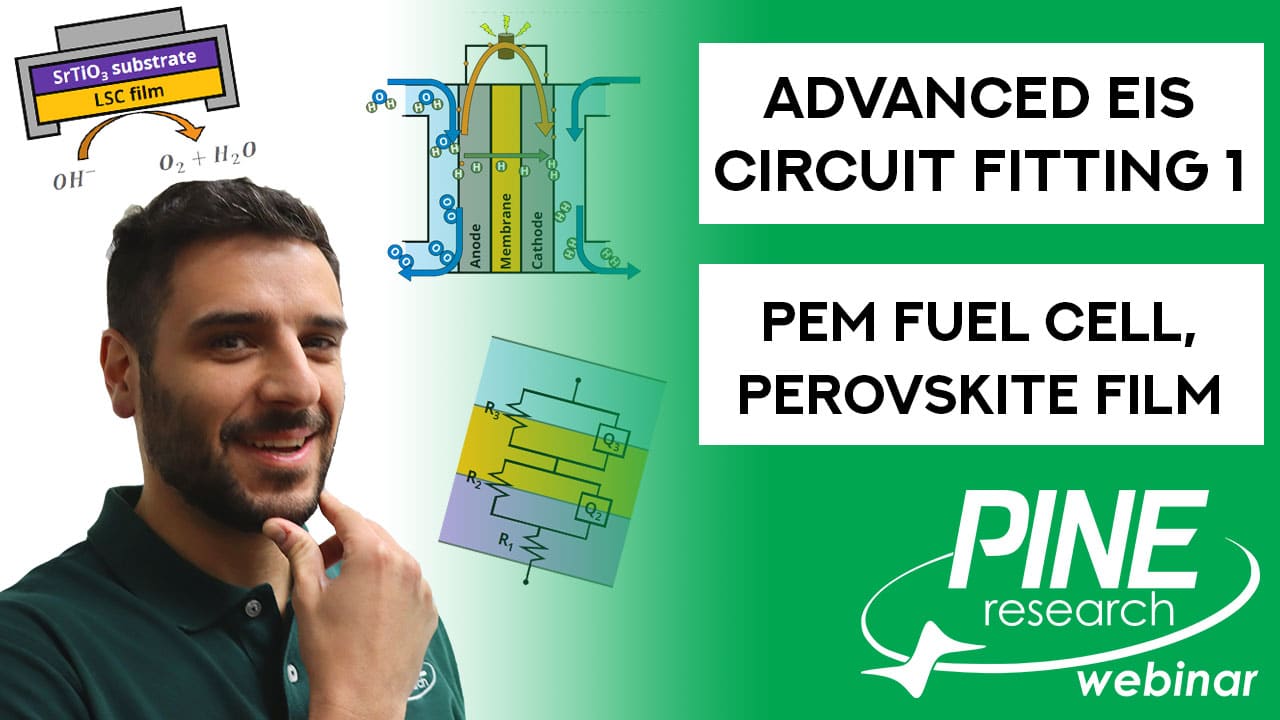Webinars
Pine Research started offering webinars in 2020, mostly as a response to the COVID-19 pandemic; however, given the attendance, there still exists a significant demand for webinars. The cornerstone webinar series is based on Electrochemical Impedance Spectroscopy (EIS). Pine Research plans to host webinars in a wide variety of electrochemical topics. This page will provide you with a list of upcoming and past webinars, with registration information when available.
Upcoming Webinars
We do not currently have any webinars scheduled. Please visit this page often and follow us on X and LinkedIn to know when webinars get scheduled. If you are looking to watch a webinar on a specific topic of significant interest, let us know and we can add it to our list.
Past Webinars
21:00 GMT
This webinar covers electrochemical impedance spectroscopy (EIS) circuit fitting, tips and tricks in AfterMath Blue software, special features, and general strategies.
13:00 GMT
This webinar covers electrochemical impedance spectroscopy (EIS) circuit fitting, tips and tricks in AfterMath Blue software, special features, and general strategies.
21:00 GMT
This webinar covers electrochemical impedance spectroscopy (EIS) parameters, potentiostatic vs. galvanostatic EIS, how to choose experimental parameters, software control, experimental flow, and real EIS experiments live.
13:00 GMT
This webinar covers electrochemical impedance spectroscopy (EIS) parameters, potentiostatic vs. galvanostatic EIS, how to choose experimental parameters, software control, experimental flow, and real EIS experiments live.
20:00 GMT
This webinar covers applications of electrochemical impedance spectroscopy (EIS), specifically electrochemical interfaces, circuit elements, Warburg models, both infinite and finite, and corrosion models.
12:00 GMT
This webinar covers applications of electrochemical impedance spectroscopy (EIS), specifically electrochemical interfaces, circuit elements, Warburg models, both infinite and finite, and corrosion models.
20:00 GMT
This webinar covers applications of electrochemical impedance spectroscopy (EIS), specifically electrochemical interfaces, circuit elements, RC/RQ circuits, capacitors vs. constant phase elements (CPEs), and series vs. embedded models.
12:00 GMT
This webinar covers applications of electrochemical impedance spectroscopy (EIS), specifically electrochemical interfaces, circuit elements, RC/RQ circuits, capacitors vs. constant phase elements (CPEs), and series vs. embedded models.
20:00 GMT
This webinar covers the basics of electrochemical impedance spectroscopy (EIS), including theory behind the technique, data processing, Bode/Nyquist plots, data accuracy and validity, and use of the Kramers-Kronig transforms.
12:00 GMT
This webinar covers the basics of electrochemical impedance spectroscopy (EIS), including theory behind the technique, data processing, Bode/Nyquist plots, data accuracy and validity, and use of the Kramers-Kronig transforms.
21:00 GMT
This webinar covers basics of how a potentiostat works, including feedback loops and operational amplifiers, as well as uncompensated resistance, where it comes from and how to correct for it.
13:00 GMT
This webinar covers basics of how a potentiostat works, including feedback loops and operational amplifiers, as well as uncompensated resistance, where it comes from and how to correct for it.
21:00 GMT
This webinar covers rotating disk electrode (RDE) and rotating ring-disk electrode (RRDE) electrochemistry, specifically the data analysis of methods such as Levich, Koutecky-Levich, Tafel, and collection efficiency.
13:00 GMT
This webinar covers rotating disk electrode (RDE) and rotating ring-disk electrode (RRDE) electrochemistry, specifically the data analysis of methods such as Levich, Koutecky-Levich, Tafel, and collection efficiency.
21:00 GMT
This webinar covers rotating disk electrode (RDE) and rotating ring-disk electrode (RRDE) electrochemistry, including the theory of kinetics and diffusion as well as methods such as Levich, Koutecky-Levich, Tafel, and collection efficiency determination. Live RRDE experiments are also shown to collect real data to be analyzed in a separate webinar.
13:00 GMT
This webinar covers rotating disk electrode (RDE) and rotating ring-disk electrode (RRDE) electrochemistry, including the theory of kinetics and diffusion as well as methods such as Levich, Koutecky-Levich, Tafel, and collection efficiency determination. Live RRDE experiments are also shown to collect real data to be analyzed in a separate webinar.
21:00 GMT
This webinar covers electrochemical impedance spectroscopy (EIS) circuit fitting, tips and tricks in AfterMath Blue software, special features, and general strategies.
13:00 GMT
This webinar covers electrochemical impedance spectroscopy (EIS) circuit fitting, tips and tricks in AfterMath Blue software, special features, and general strategies.
21:00 GMT
This webinar covers electrochemical impedance spectroscopy (EIS) parameters, potentiostatic vs. galvanostatic EIS, how to choose experimental parameters, software control, experimental flow, and real EIS experiments live.
13:00 GMT
This webinar covers electrochemical impedance spectroscopy (EIS) parameters, potentiostatic vs. galvanostatic EIS, how to choose experimental parameters, software control, experimental flow, and real EIS experiments live.
21:00 GMT
This webinar covers applications of electrochemical impedance spectroscopy (EIS), specifically electrochemical interfaces, circuit elements, Warburg models, both infinite and finite, and corrosion models.
13:00 GMT
This webinar covers applications of electrochemical impedance spectroscopy (EIS), specifically electrochemical interfaces, circuit elements, Warburg models, both infinite and finite, and corrosion models.
21:00 GMT
This webinar covers applications of electrochemical impedance spectroscopy (EIS), specifically electrochemical interfaces, circuit elements, RC/RQ circuits, capacitors vs. constant phase elements (CPEs), and series vs. embedded models.
13:00 GMT
This webinar covers applications of electrochemical impedance spectroscopy (EIS), specifically electrochemical interfaces, circuit elements, RC/RQ circuits, capacitors vs. constant phase elements (CPEs), and series vs. embedded models.
21:00 GMT
This webinar covers the basics of electrochemical impedance spectroscopy (EIS), including theory behind the technique, data processing, Bode/Nyquist plots, data accuracy and validity, and use of the Kramers-Kronig transforms.
13:00 GMT
This webinar covers the basics of electrochemical impedance spectroscopy (EIS), including theory behind the technique, data processing, Bode/Nyquist plots, data accuracy and validity, and use of the Kramers-Kronig transforms.
21:00 GMT
This webinar covers rotating disk electrode (RDE) and rotating ring-disk electrode (RRDE) electrochemistry, specifically the data analysis of methods such as Levich, Koutecky-Levich, Tafel, and collection efficiency.
13:00 GMT
This webinar covers rotating disk electrode (RDE) and rotating ring-disk electrode (RRDE) electrochemistry, specifically the data analysis of methods such as Levich, Koutecky-Levich, Tafel, and collection efficiency.
21:00 GMT
This webinar covers rotating disk electrode (RDE) and rotating ring-disk electrode (RRDE) electrochemistry, including the theory of kinetics and diffusion as well as methods such as Levich, Koutecky-Levich, Tafel, and collection efficiency determination. Live RRDE experiments are also shown to collect real data to be analyzed in a separate webinar.
13:00 GMT
This webinar covers rotating disk electrode (RDE) and rotating ring-disk electrode (RRDE) electrochemistry, including the theory of kinetics and diffusion as well as methods such as Levich, Koutecky-Levich, Tafel, and collection efficiency determination. Live RRDE experiments are also shown to collect real data to be analyzed in a separate webinar.
20:00 GMT
This webinar covers advanced circuit fitting of electrochemical impedance spectroscopy (EIS) data submitted by researchers to Pine Research. Two cases are analyzed: a nickel hydroxide electrode used for glucose oxidation, and a coin cell battery with blocking conditions used to determine tortuosity via transmission line circuit models.
12:00 GMT
This webinar covers advanced circuit fitting of electrochemical impedance spectroscopy (EIS) data submitted by researchers to Pine Research. Two cases are analyzed: a nickel hydroxide electrode used for glucose oxidation, and a coin cell battery with blocking conditions used to determine tortuosity via transmission line circuit models.
19:30 GMT
This webinar covers electrochemical impedance spectroscopy (EIS) circuit fitting, tips and tricks in AfterMath Blue software, special features, and general strategies.
14:00 GMT
This webinar covers electrochemical impedance spectroscopy (EIS) circuit fitting, tips and tricks in AfterMath Blue software, special features, and general strategies.
05:00 GMT
This webinar covers electrochemical impedance spectroscopy (EIS) circuit fitting, tips and tricks in AfterMath Blue software, special features, and general strategies.
19:30 GMT
This webinar covers electrochemical impedance spectroscopy (EIS) parameters, potentiostatic vs. galvanostatic EIS, how to choose experimental parameters, software control, experimental flow, and real EIS experiments live.
14:00 GMT
This webinar covers electrochemical impedance spectroscopy (EIS) parameters, potentiostatic vs. galvanostatic EIS, how to choose experimental parameters, software control, experimental flow, and real EIS experiments live.
05:00 GMT
This webinar covers electrochemical impedance spectroscopy (EIS) parameters, potentiostatic vs. galvanostatic EIS, how to choose experimental parameters, software control, experimental flow, and real EIS experiments live.
19:30 GMT
This webinar covers applications of electrochemical impedance spectroscopy (EIS), specifically electrochemical interfaces, circuit elements, Warburg models, both infinite and finite, and corrosion models.
14:00 GMT
This webinar covers applications of electrochemical impedance spectroscopy (EIS), specifically electrochemical interfaces, circuit elements, Warburg models, both infinite and finite, and corrosion models.
05:00 GMT
This webinar covers applications of electrochemical impedance spectroscopy (EIS), specifically electrochemical interfaces, circuit elements, Warburg models, both infinite and finite, and corrosion models.
19:30 GMT
This webinar covers applications of electrochemical impedance spectroscopy (EIS), specifically electrochemical interfaces, circuit elements, RC/RQ circuits, capacitors vs. constant phase elements (CPEs), and series vs. embedded models.
14:00 GMT
This webinar covers applications of electrochemical impedance spectroscopy (EIS), specifically electrochemical interfaces, circuit elements, RC/RQ circuits, capacitors vs. constant phase elements (CPEs), and series vs. embedded models.
05:00 GMT
This webinar covers applications of electrochemical impedance spectroscopy (EIS), specifically electrochemical interfaces, circuit elements, RC/RQ circuits, capacitors vs. constant phase elements (CPEs), and series vs. embedded models.
19:30 GMT
This webinar covers the basics of electrochemical impedance spectroscopy (EIS), including theory behind the technique, data processing, Bode/Nyquist plots, data accuracy and validity, and use of the Kramers-Kronig transforms.
14:00 GMT
This webinar covers the basics of electrochemical impedance spectroscopy (EIS), including theory behind the technique, data processing, Bode/Nyquist plots, data accuracy and validity, and use of the Kramers-Kronig transforms.
05:00 GMT
This webinar covers the basics of electrochemical impedance spectroscopy (EIS), including theory behind the technique, data processing, Bode/Nyquist plots, data accuracy and validity, and use of the Kramers-Kronig transforms.
20:00 GMT
This webinar covers advanced circuit fitting of electrochemical impedance spectroscopy (EIS) data submitted by researchers to Pine Research. Two cases are analyzed: a coated steel corrosion and use of a shunt, and a modified screen-printed electrode (SPE) biosensor.
14:00 GMT
This webinar covers advanced circuit fitting of electrochemical impedance spectroscopy (EIS) data submitted by researchers to Pine Research. Two cases are analyzed: a coated steel corrosion and use of a shunt, and a modified screen-printed electrode (SPE) biosensor.
05:00 GMT
This webinar covers advanced circuit fitting of electrochemical impedance spectroscopy (EIS) data submitted by researchers to Pine Research. Two cases are analyzed: a coated steel corrosion and use of a shunt, and a modified screen-printed electrode (SPE) biosensor.
20:00 GMT
This webinar covers advanced circuit fitting of electrochemical impedance spectroscopy (EIS) data submitted by researchers to Pine Research. Two cases are analyzed: a proton-exchange membrane (PEM) fuel cell and a perovskite film.
12:00 GMT
This webinar covers advanced circuit fitting of electrochemical impedance spectroscopy (EIS) data submitted by researchers to Pine Research. Two cases are analyzed: a proton-exchange membrane (PEM) fuel cell and a perovskite film.
20:00 GMT
This webinar covers electrochemical impedance spectroscopy (EIS) circuit fitting, tips and tricks in AfterMath Blue software, special features, and general strategies.
12:00 GMT
This webinar covers electrochemical impedance spectroscopy (EIS) circuit fitting, tips and tricks in AfterMath Blue software, special features, and general strategies.
21:00 GMT
This webinar covers electrochemical impedance spectroscopy (EIS) parameters, potentiostatic vs. galvanostatic EIS, how to choose experimental parameters, software control, experimental flow, and real EIS experiments live.
13:00 GMT
This webinar covers electrochemical impedance spectroscopy (EIS) parameters, potentiostatic vs. galvanostatic EIS, how to choose experimental parameters, software control, experimental flow, and real EIS experiments live.
21:00 GMT
This webinar covers applications of electrochemical impedance spectroscopy (EIS), specifically electrochemical interfaces, circuit elements, Warburg models, both infinite and finite, and corrosion models.
13:00 GMT
This webinar covers applications of electrochemical impedance spectroscopy (EIS), specifically electrochemical interfaces, circuit elements, Warburg models, both infinite and finite, and corrosion models.
21:00 GMT
This webinar covers applications of electrochemical impedance spectroscopy (EIS), specifically electrochemical interfaces, circuit elements, RC/RQ circuits, capacitors vs. constant phase elements (CPEs), and series vs. embedded models.
13:00 GMT
This webinar covers applications of electrochemical impedance spectroscopy (EIS), specifically electrochemical interfaces, circuit elements, RC/RQ circuits, capacitors vs. constant phase elements (CPEs), and series vs. embedded models.
21:00 GMT
This webinar covers the basics of electrochemical impedance spectroscopy (EIS), including theory behind the technique, data processing, Bode/Nyquist plots, data accuracy and validity, and use of the Kramers-Kronig transforms.
13:00 GMT
This webinar covers the basics of electrochemical impedance spectroscopy (EIS), including theory behind the technique, data processing, Bode/Nyquist plots, data accuracy and validity, and use of the Kramers-Kronig transforms.

